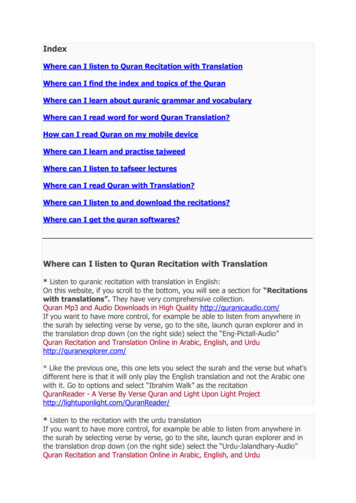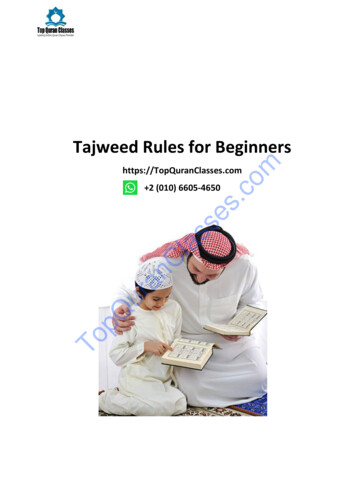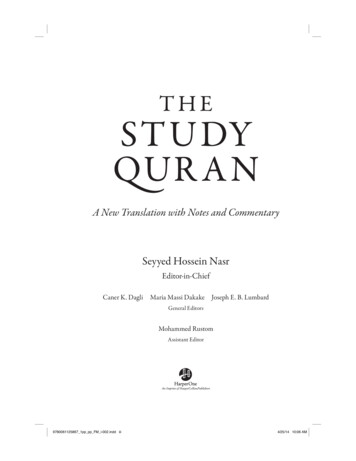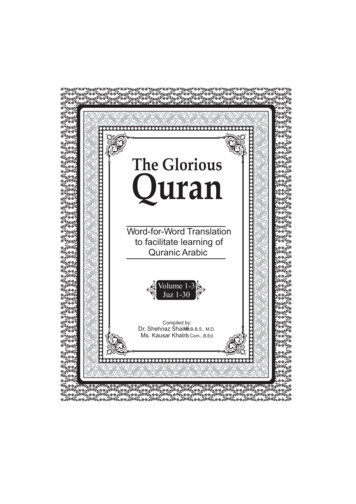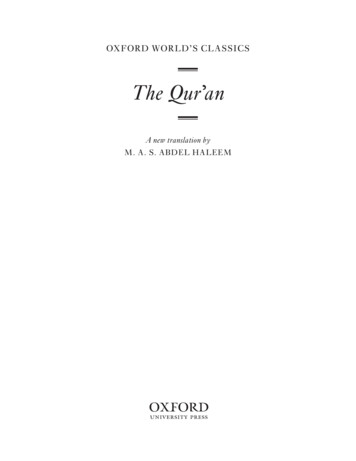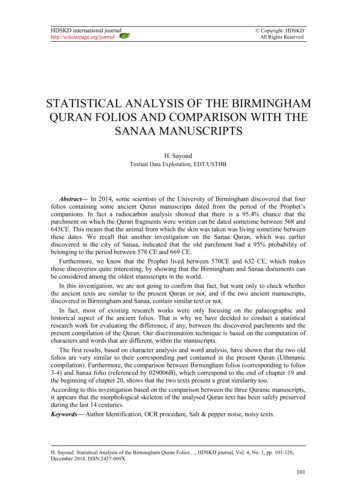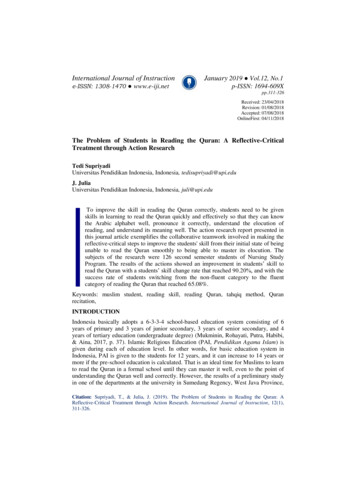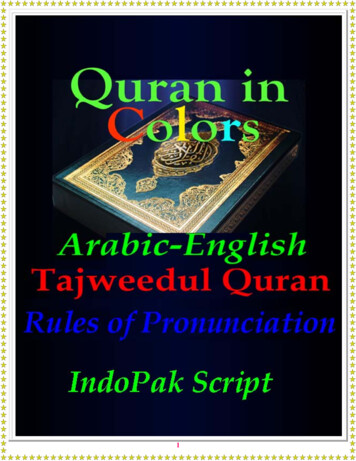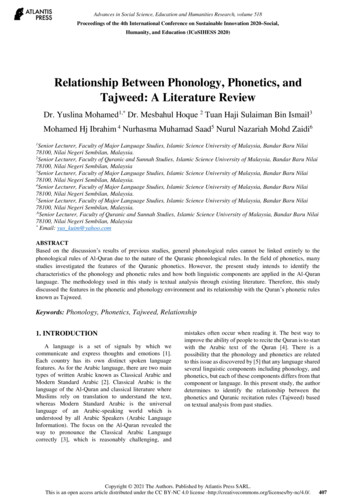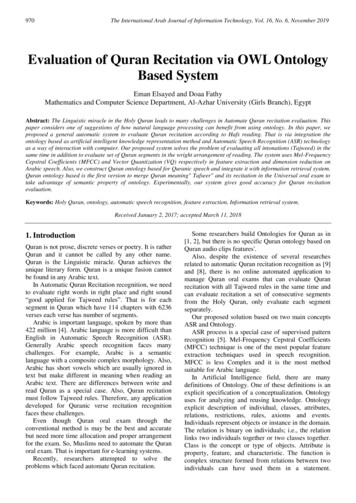
Transcription
970The International Arab Journal of Information Technology, Vol. 16, No. 6, November 2019Evaluation of Quran Recitation via OWL OntologyBased SystemEman Elsayed and Doaa FathyMathematics and Computer Science Department, Al-Azhar University (Girls Branch), EgyptAbstract: The Linguistic miracle in the Holy Quran leads to many challenges in Automate Quran recitation evaluation. Thispaper considers one of suggestions of how natural language processing can benefit from using ontology. In this paper, weproposed a general automatic system to evaluate Quran recitation according to Hafs reading. That is via integration theontology based as artificial intelligent knowledge representation method and Automatic Speech Recognition (ASR) technologyas a way of interaction with computer. Our proposed system solves the problem of evaluating all intonations (Tajweed) in thesame time in addition to evaluate set of Quran segments in the wright arrangement of reading. The system uses Mel-FrequencyCepstral Coefficients (MFCC) and Vector Quantization (VQ) respectively in feature extraction and dimension reduction onArabic speech. Also, we construct Quran ontology based for Quranic speech and integrate it with information retrieval system.Quran ontology based is the first version to merge Quran meaning" Tafseer" and its recitation in the Universal oral exam totake advantage of semantic property of ontology. Experimentally, our system gives good accuracy for Quran recitationevaluation.Keywords: Holy Quran, ontology, automatic speech recognition, feature extraction, Information retrieval system.Received January 2, 2017; accepted March 11, 20181. IntroductionQuran is not prose, discrete verses or poetry. It is ratherQuran and it cannot be called by any other name.Quran is the Linguistic miracle. Quran achieves theunique literary form. Quran is a unique fusion cannotbe found in any Arabic text.In Automatic Quran Recitation recognition, we needto evaluate right words in right place and right sound“good applied for Tajweed rules”. That is for eachsegment in Quran which have 114 chapters with 6236verses each verse has number of segments.Arabic is important language, spoken by more than422 million [4]. Arabic language is more difficult thanEnglish in Automatic Speech Recognition (ASR).Generally Arabic speech recognition faces manychallenges. For example, Arabic is a semanticlanguage with a composite complex morphology. Also,Arabic has short vowels which are usually ignored intext but make different in meaning when reading anArabic text. There are differences between write andread Quran as a special case. Also, Quran recitationmust follow Tajweed rules. Therefore, any applicationdeveloped for Quranic verse recitation recognitionfaces these challenges.Even though Quran oral exam through theconventional method is may be the best and accuratebut need more time allocation and proper arrangementfor the exam. So, Muslims need to automate the Quranoral exam. That is important for e-learning systems.Recently, researchers attempted to solve theproblems which faced automate Quran recitation.Some researchers build Ontologies for Quran as in[1, 2], but there is no specific Quran ontology based onQuran audio clips features'.Also, despite the existence of several researchesrelated to automatic Quran recitation recognition as [9]and [8], there is no online automated application tomanage Quran oral exams that can evaluate Quranrecitation with all Tajweed rules in the same time andcan evaluate recitation a set of consecutive segmentsfrom the Holy Quran, only evaluate each segmentseparately.Our proposed solution based on two main conceptsASR and Ontology.ASR process is a special case of supervised patternrecognition [5]. Mel-Frequency Cepstral Coefficients(MFCC) technique is one of the most popular featureextraction techniques used in speech recognition.MFCC is less Complex and it is the most methodsuitable for Arabic language.In Artificial Intelligence field, there are manydefinitions of Ontology. One of these definitions is anexplicit specification of a conceptualization. Ontologyuses for analyzing and reusing knowledge. Ontologyexplicit description of individual, classes, attributes,relations, restrictions, rules, axioms and events.Individuals represent objects or instance in the domain.The relation is binary on individuals; i.e., the relationlinks two individuals together or two classes together.Class is the concept or type of objects. Attribute isproperty, feature, and characteristic. The function iscomplex structure formed from relations between twoindividuals can have used them in a statement.
Evaluation of Quran Recitation via OWL Ontology Based SystemRestrictions represented formally stated descriptionsuse in some assertion. The rule is statement used inlogical inference to draw from assertion. An axiom isassertion in logical form. The rules and axioms areused together for comparison the all theory that theontology describes in the domain of application. Theevent is changing of relations. The previous Ontologydefinition and structure were summarized fromreference [15].In our proposed system, we use Ontology WebLanguage (OWL) ontology based to represent andclassify Quran acoustic features. Using OWL to createontology based is suitable for e-learning and onlineapplication.The semantic was assigned to the verses or chapters,the segments inherit the verse or chapter concepts inthe right arrangement of Quran reading. Usingontology decrease processing time and retrieve featuresof verse segments in right arrangement.This paper organizes as the following: section 2shows the related work for recognition of Quranrecitation and Quran ontology. Section 3 presents theproposed method for Automatic evaluation of Quranrecitation and its phases. The analysis of results wasdiscussed in section 4. Finally, section 5 presents theconclusion and further work.2. Literature Review2.1. Automatic Speech Recognition (ASR) onQuran Recitation ApplicationThere are many researches in speech recognition ingeneral. The important and complexity of Quranrecitation recognition system tends to find a fewresearches on it.Authors in reference [14] provides a research relatedto Quran. Where, they can assist and ensure correctpronunciation, readings and interpretations in trueQuranic recitation rules. That is based on the speechrecognition for “Warsh”.They used database to storethe recitation features of true sample collected fromexpert reciters. MFCC used in features extraction, andHidden Markov Models (HMM) used in classification.Also, researches in [13] used MFCC and HMM onanother type of recitation for Holy Quran.Also, “E Hafiz” system in [11], and system inreference [10] used MFCC for feature extraction andVector Quantization (VQ) for feature classification.Systems stored the trained features in codebook.Authors in reference [9] proposed automatedtajweed checking rules engine for quran learning. Thatis by using MFCC to extract features of verserecitation and trained verse samples calculated andstored in HMM database. But, the engine of the systemtested only on selected Tajweed rule of “Al-Fatihah”.Ismail et al. [8] investigated a speech recognitionsystem for Tajweed Rule Checking Tool to help971students to learn and revise proper Quran recitation bythemselves. They used also MFCC as featureextraction technique and vector quantization VQ asclassification technique and data reduction technique.From the result, it shows that the MFCC-VQ achievesbetter results in terms of speed performance thanconventional MFCC. Vector quantization is used inthis work to cluster the coefficient vector extractedfrom the speech samples on their sound class for eachof “Qalqalah letters ( ”)ق ط ب ج د . The accuracy wasabout 82.1-95 %.But the system applied only on “Tajweed Qalqalah”rule. Also, features of trained Quran verse samplescalculated and stored in VQ codebook. The proposedsystem in this reference evaluates one verse or wordcontain “Qalqalah letter” at once.2.2. Using Ontology with Quran ApplicationsIn Islamic world, researchers interest to study Quran inall fields. In computer science, Ontology used tocapture knowledge from Quran in some domains ofinterest by describing concepts in these domains andrelationships that are held between those concepts.Many researches have been done in retrievingknowledge from Quran using semantic search.Reference [2] proposed a search tool called asemantic search tool for Quran based on Qur’anicontologies and surveys most existing Quranicontologies and what are their deficiencies as ontologiesin references [1, 12]. Where, reference [12] extractsverses according to the concept. Reference [1] is theQuranic Arabic Corpus which is the first manuallyverified and computationally analyzed Quran corpusmorphology.Reference [7] reports an experience of developingontology on Quranic text for “Juz’ Ammi”. This Quranontology supports contextual information andrepresents authentic information from the Quran butnot support acoustic features of Quran recitation.Briefly, there exist Desktop and Web applicationshave been developed to retrieve knowledge fromQuran. Most of these applications use keyword searchtechniques. However, some researchers have proposedframeworks for a Quranic semantic search tool basedon concepts. But no ontologies include acousticfeatures of Quran words or sounds of segments.A good resource for Quran Ontology is availablebut, we can't use any Quran Ontology was prepared.Because our Quran ontology developed for differentaim, so we propose Quran ontology represents acousticfeatures of Quran recitation.3. Proposed System ArchitectureIn this section, we propose a system to evaluate Quranrecitation in correct pronunciation and Holy QuranTajweed rules according to “Hafs from Asim reading”.
972The International Arab Journal of Information Technology, Vol. 16, No. 6, November 2019 The creation of the proposed system has fourmain phases: The first phase is building Quranlightweight ontology using protégé as ontologyeditor.The second phase is training phase, which is datapreparation, features extraction using MFCC and VQof the training set.The third phase is inserting phase, which is to insertthe result of analysis from the training phase in Quranlightweight ontology result from the first phase to getthe heavy ontology.When user uses the system to test his reading, thesystem passes through other two phases: analysis phaseand evaluation phase.The analysis phase is to prepare date, extractfeatures from the user speech and applying VQ.The evaluating phase is by comparing betweencertain selected classes that is retrieved using SPARQLfrom ontology and the result of the analysis phase.In the following subsections, we explain theproposed system phases in more details.3.1. Building Quran Lightweight OntologyQuran is the immortal miracle from God for humans.Quran consists of 30 divisions (Juz), 114 chapters(Surah), 6236 verses (Ayah), and less than 80,000words. The verse contains one or more sentences toform the verse. A group of verses form a chapter with agiven unique name e.g., (Al-Baqarah, Ali-Imran, AnNisa, Al-Ikhlas).Quran Content Hierarchy is as shownin Figure 1.Quran recitation consists of many rules needed to beconsidered when any one read Quran verse these rulesnamed with Tajweed rules. Mistakes in recitation ofQuran are forbidden. These errors may include missingwords, verse, misreading vowel pronunciations,punctuations, and accents. Also, the characters in theQuran may have a diacritic written either above orbelow a character. This diacritic can change thepronunciation and meaning of the word. Tajweed rulesensure that the recitation is performed incorrectlypronunciation and at a moderate speed withoutchanging the meaning. The pronunciation andrecitation for each letter of Quran should follow itsright and its due. The rights of a letter are thecharacteristics that are always connected to it. The dueof a letter is characteristic that is present sometimes butnot always, such as prolongation “Madd”, shorten“Istifāl”, thinning “Tarqeeq”, thickening “Tafkheem”and other such phonetic methods of a merging“Idghaam”, clearly mentions “Idh-haar”, change“Iqlab”, hide “Ikhfa” [6].The spread of the Quran printed “Hafs” is one of thereasons of publicity and the many who read themconfirmed by this fact so, the proposed Quran ontologybased on “Hafs reading”.The components of Quran ontology are as shown inFigure 2. The two main concepts are “Quran” and“Tajweed rules”. Chapter “surah” and division “Juz”are the subclasses of Quran. Qurandivision “Juz”subclass classifies into thirty subclasses, and chapter“Surah” subclass classifies into one hundred andfourteen. Each chapter has different number of versesas subclasses. Finally, each verse has different numberof arranged segments as individuals.Properties we are used to describe resources; theygive more description to a class/concept or subclass:a) Data property that used for relationship betweenclass and its literal are:Figure 1. Quran contents hierarchy.The advantages of using the Quran normalclassification in the Quran Ontology based are: The uniqueness of the words and segments. Respecting constrain of the arrangement betweenverses. Ability to refinement the ontology to cover themeaning. mfcc matrix value: datatype property that relatesQuran segment to his MFCC voice features. Segment text: datatype property that relates Quransegment to his Arabic text. threshold distance value: datatype property thatrelates Quran segment to the distance value betweenthe segment MFCC features value and other truerecitation of the same segment. Therefore, whenuser recite segment, it is compared with the storedone.b) Object property describes the relationship betweenclasses are “belongs to”.
Evaluation of Quran Recitation via OWL Ontology Based System973Figure 2. Quran ontology graph.We will use Quran ontology to support speechrecitation recognition of Quran. That is via store speechfeatures of Quran segments as data property of Quranrecitation segment.3.2. Training PhaseTraining phase is a process of enrolling a new speechsample of a distinct verse to the Quran ontology based.That is by constructing a model of the verse based onthe features extracted from the verse’s segments speechsamples.In This phase, we analyze the Quran speech usingthe MFCC because it is based on human perceptionexperiments.We start by samples of five recorded audio files ofQuran to different good Quran reciters in “Hafsreading” i.e., reciters were chosen based on thecommitment ‘Tajweed rules’ which called “He hasEjaza”. That is because an appropriate speech corpus ofthe Quranic sounds is rare available. We record thesample in wave format.The three stages of training phase are datapreparation, feature extraction, and vector quantization,and then inserted the output of training phase intoQuran ontology are shown in Figure 3.Figure 3. Training phase.3.2.1. Data PreparationFor more accuracy result, in data preparation step wedelete noise from the audio sample set. That’s bydetecting the end points to delete the unnecessaryframe. That is removing silence parts. Then we need tocancel the noise from signals of each segment inQuran. That’s by using pre-emphasis filter. To performthe pre-emphasis process, the application of first orderFinite Impulse Response (FIR) filter is applied ondigitized signal. The equation used to apply FIR filteris Equation (1).
974The International Arab Journal of Information Technology, Vol. 16, No. 6, November 2019𝑌[𝑛] 𝑋[𝑛] 𝛼 𝑋[𝑛 1](1)Where, Y[n] is the output of the signal X[n] is a speechsignal. And α represents the pre-emphasis factor.3.2.2. MFCC Feature Extraction 2𝜋𝑗𝐾𝑛/𝑁𝑌2 [𝑛] 𝑁 1𝐾 0 𝑌1 [𝐾] 𝑒(4)Where, k 0, 1, 2, 3, , N-1 and Y2[n] is the output ofFourier Transform of Y1[k].4. Mel Filter Bank: it uses to emphasize the lowfrequency components because low frequencies inspeech signal contain useful and importantinformation compare to higher ones. Mel scale isapplied by the Equation (5) to compute the Melfrequencies for a frequency f in Hz:𝑀𝑒𝑙 𝑆𝑐𝑎𝑙𝑒(𝑓) 2592 𝑙𝑜𝑔10(1 𝑓/700) (5)Figure 4. Steps involve in MFCC Feature extraction.The feature extraction process transforms the rawsignal into feature vectors. MFCC is one of the besttechniques that used for speech feature extractionpurpose and give good results in the field of voicecontent matching systems. In our proposed system, weuse MFCC twice in training phase and testing phase.The MFCC feature extraction technique consists of sixsteps as shown in Figure 4 which are:1. Framing: After pre-emphases filtered input speech isframed, each segment's signal is segmented into thesmall frames with the time length 23msec. frames toconvert non-stationary signals into qui-stationaryformat. Also, theses frames are further blockedoverlap, every frame contains the 11.5 msec. of itsprevious frame’s data. It performs overlap to reducethe chances of losing information lies at the end ofeach frame that may be crashed during segmentingof speech.2. Windowing:Performingwindowingmeansmultiplying each frame with Hamming Window.This shrink the signal values toward zero level at theboundaries of each frame. For each speech signalframed is windowed to minimize the signaldiscontinuities at the start and end of the frame. TheHamming Window is defined by Equation (2).𝑤(𝑛) 0.54 0.46𝑐𝑜𝑠(2𝜋𝑛/ 𝑁 1)(2)Where, N is the total number of speech sample in eachframe, n is any value from range 0 to N-1, (0 n N 1).Thus, the result of the windowing can be shownbased on Equation (3).𝑌(𝑛) 𝑋(𝑛) 𝑤(𝑛)frequency component in original signal to frequencydomain. The DFT is performed by Equation (4).(3)Where, Y[n] is the windowing signal and X[n] is aspeech signal.3. Discrete Fourier Transformation (DFT): It is appliedon windowed signal obtained from previous step, byusing of Fast Fourier Transform (FFT) algorithm totransfer each windowed frame from time domain tofrequency domain. The output of this transformationis a complex number, representing each frequencyband (0 to N-1) having magnitude and phase of that5. Reduce Mel filter bank values: that is by taking thenatural logarithm of the Mel filtered speechsegments. The effect of taking natural log isreducing the values of Mel filter bank.6. Inverse Discrete Fourier Transformation (IDFT): Itconverts the speech signal from frequency back totime domain.Finally, we can get the output of the MFCC in the formof feature vector by using this Equation (6).𝑌[𝑛] 𝑁 1𝐾 0 𝑋[𝐾] 𝑐𝑜𝑠 [12𝑛(𝐾 )𝜋𝑁](6)Where n 1,2, 3 ., LX[k] is the logged value of each Mel filtered speechsegment. L is the required number of Mel CepstralCoefficient taken from N filter tapes of each frame.3.2.3. Vector QuantizationFor mapping vectors from a large vector space to afinite number we use the VQ technique. VQ givesdifferent size of matrix as the output. Experimentally,we choose a matrix of 12 16 for each segment whichgives high accuracy.This step is performed in features training and infeatures matching/ testing.3.3. Inserting Data Property into Ontology(Inserting Phase)The output of VQ - a features vector- of Quran speechconverts to a character vector. We insert a charactervector into the OWL ontology based of Quran as"mfcc matrix value".Speech vector was extracted foreach segment in Quran verses for five different goodreaders of Quran. Threshold distance value for eachsegment that determine in training phase also insertedinto Quran ontology based "threshold distance value".Text of each segment inserted as "segment text".We create another two processes to test the userreading. They are the analysis phase and evaluatingphase. Figure 5 shows the relation and details of thesystem analysis phase and the evaluation phase.
Evaluation of Quran Recitation via OWL Ontology Based System3.4. The Testing Phase3.4.1. The Analysis PhaseIn this phase, we prepare data, extract features andapplying VQ of each segment user' reading in the samesteps as training phase.9751. To evaluate all Tajweed rules include Tajweed rulesthat found in two consecutive words as example inverse 4 of Sourate “Al-Ikhlas” “ " يكن له , where mergeletter “ ”ن and “ ”ل without nasal tone.2. The problem of automatic segmentation in Arabiclanguage specially segmentation in Quran.4. Case Study and Result AnalysisFigure 5. System analysis and evaluation phase(testing phase).3.4.2. The Evaluation PhaseThe main process in this phase is comparing processbetween the output of analysis phase and the selectedpart of Quran Ontology. This phase needs connectionbetween MATLAB (2015) framework, and formalOntology which solved in reference [3] in computervision. We use the similar idea in speech recognition.That is by SPARQL query Language with OWLOntology based. The way of building Quran ontologyallows evaluating recitation of any Quran part. Theadvantage of this phase is supporting easy evaluation inthe right arrangement.To evaluate segment, the output of analysis phase iscompared with “mfcc matrix value” data property ofthe correspond segment verified recitation where 5stored features vectors for each segment stored inQuran ontology and retrieved using Sparql. Thencomparing the result distances with threshold distance.For each segment recitation considered true if distancesgreater than the threshold distance value at least for 2stored features vector else it considered mistakes.The score is calculating by adding one mark for eachright segment then calculate the percentage between thesum of right segments and the sum of all segments ineach verse. The result inserts in student database in elearning system or reported to user directly.Although of segment consists of number of words,the comparison is performed on segment level. That isbecause of two reasons:To implement the proposed system, we create OWLQuran Ontology based by Protégé 4.2 editor. Thetraining samples according to “Hafs reading” are fiveAudio files of good reciters. Then to test the system,we apply it on some samples of ten readers.The two biggest challenges of our system are theaccuracy and speed performance. The obtained result isgood considering constrains of recording.First, in our case, the True Positive (TP) is a rightrecitation considered evaluated as right, False Positive(FP) is a wrong considered evaluated as right, TrueNegative (TN) is for the wrong recitation consideredevaluated as wrong, and False Negative (FN) is a rightrecitation considered evaluated as wrong. These fourvalues are used to compute accuracy parameters likerecall, Precision and F-measure. We used Formula7 tocompute our system recall, 8to compute Precision andFormula9 to compute F-measure.𝑇𝑃𝑟𝑒𝑐𝑎𝑙𝑙 𝑝𝑟𝑒𝑐𝑖𝑠𝑖𝑜𝑛 𝐹 𝑚𝑒𝑎𝑠𝑢𝑟𝑒 (7)𝑇𝑃 𝐹𝑁𝑇𝑃𝑇𝑃 𝐹𝑃(8)2 𝑝𝑟𝑒𝑐𝑖𝑠𝑖𝑜𝑛 ��𝑜𝑛 𝑟𝑒𝑐𝑎𝑙𝑙(9)The recall achieved in our proposed system on selectedchapter as “Al-Ikhlas” is about92%, precision about81% and F-measure about 86%.The parameters we are used shown in Table 1.Table 1. Parameters were used in stages of our work.ParameterSampling RatePre-emphases CoefficientFrame SizeOverlap DurationHamming WindowNumber of Cepstral 124Second, the speed performance improves using VQas data reduction of MFCC features and using OWLontology based to store and classify speech features.We used the Real-Time Factor (RTF) to measure theruntime speed. Where, it has been a widely-used metricsystem for measuring the speed of automated speechrecognition. Real-Time Factor computed usingEquation (10). In Table 2 the comparison between ourproposed system (MFCC-VQ with OWL ontology
976The International Arab Journal of Information Technology, Vol. 16, No. 6, November 2019based) and the same system when use codebook insteadof using Quran Ontology in certain segment.Real-Time Factor (RTF) execution time/ recording duration(10)Table 2. Comparison between our proposed system and MFCC-VQwith VQ codebook.MetricsExecution Time (s)Recording Duration (s)Real-Time FactorMFCC-VQ with OWLontology based0.341544seconds3s 970ms0.0860MFCC-VQ with VQcodebook1.044321seconds3s 970ms0.2631From Table 2, it can be observed that the speedperformance to evaluate one Quran segment if corrector not of the proposed MFCC-VQ with ontology isfaster than the MFCC-VQ with VQ codebook by67.3% real-time factor improvement. ImprovementReal-Time Factor computes by Equation ��� (𝑅𝑇𝐹)(%) sequence of Quran segments recitation in rightarrangement of Quran reading. From the results, itshows that the MFCC with Quran ontology achievesbetter results in terms of speed performance thanconventional MFCC with VQ codebook.Further works will generalize the process toultimately cover all chapters of the Holy Quran to addmore benefits from the ontology of Quran to the users.Weplan to complete the universal Quran Ontology bymerging Quran Tajweed Ontology and Quran TafseerOntology. That is to enhance the electronic oral examfor all Islamic Religion subjects. Also, we willameliorate the accuracy of the system by enhance thesegmentation rule and increase the training set.References[1](𝑀𝐹𝐶𝐶 𝑉𝑄 𝑐𝑜𝑑𝑒𝑏𝑜𝑜𝑘(𝑅𝑇𝐹)– 𝑃𝑟𝑜𝑝𝑜𝑠𝑒𝑑 𝑠𝑦𝑠𝑡𝑒𝑚(𝑅𝑇𝐹))/ 𝑀𝐹𝐶𝐶 𝑉𝑄 𝑐𝑜𝑑𝑒𝑏𝑜𝑜𝑘(𝑅𝑇𝐹) 100Comparing with the performance between the proposedsystem and others. In reference [8], recognitionaccuracy achieved by using MFCC-VQ method were83.9% for male and the real time factor obtained wasabout 0.156. This indicates that our proposed methodwhich hybrid MFCCVQ with ontology is processed ina real time.In further work we will integrate our Quran ontologyto be in word level or phoneme level in evaluationprocess. That’s needing to ameliorate Quran Ontologyby merging with Tajweed rules Ontology as shown inFigure 6.[2][3][4][5][6]Figure 6. Tajweed Rules Ontology as a Part of Quran Ontology.[7]5. ConclusionsThis paper proposed a system using ontology withAutomatic Speech Recognition (ASR) in Arabic oralexam. This system connects ASR by MATLABframework with formal ontology. VQ used as datareduction of MFCC features and OWL ontology basedused to store and classify speech features. We apply theidea on the Holy Quran.The proposed system can evaluate Quran recitationwith Tajweed rules for any user. It can evaluate[8][9]Abbas N., Aldhubai L., Al-Khalifa H., AlqassemZ., Atwell E., Dukes K., Sawalha M., and SharafA., “Unifying Linguistic Annotations andOntologies for the Arabic Quran,” in Proceedingsof WACL’2 2nd Workshop on Arabic CorpusLinguistics, UK, 2013.Alqahtani M. and Atwell E., “Arabic QuranicSearch Tool Based on Ontology,” InternationalConference on Applications of Natural Languageto Information Systems, Salford, pp. 478-485,2016.Conigliaro D. and Cristani M., “Computer Visionmeets Formal Ontology Handout 1,” Available CVONTO1.pdf, Last Visited, 2015.Elabd E., Alshari E., and Abdulkader � The International Arab Journal ofInformation Technology, vol. 12, no. 3, pp. 311316, 2015.Gamit M., Dhameliya K., and Bhatt : A Review,” International Journal ofEmergingTechnologyandAdvancedEngineering, vol. 5, no. 2, pp. 58-63, 2015.Harrag A. and Mohamadi T., “QSDAS: NewQuranic Speech Database for Arabic SpeakerRecognition,” Arabian Journal for Science andEngineering, vol. 35, no. 2, pp. 7-20, 2010.Iqbal R., Mustapha A., and Yusoff Z., “AnExperience of Developing Quran Ontology withContextual Information Support,” MulticulturalEducation and Technology Journal, vol. 7, no. 4,pp. 333-343, 2013.Ismail A., Idris M., Noor N., Razak Z., andYusoff Z., “Mfcc-Vq Approachfor QalqalahTajweed Rule Checking,” Malaysian Journal ofComputer Science, vol. 27, no. 4, pp. 275-293,2014.Ibrahim J., Mohd Y., Zaiki R., and Noor N.,“Automated Tajweed Checking Rules Engine for
Evaluation of Quran Recitation via OWL Ontology Based System[10][11][12][13][14][15]Quranic Learning,” Multicultural Education andTechnology Journal, vol. 7, no. 4, pp. 275-287,2013.Muhammad A., Qayyum Z., Mirza W., TanveerS., Syed A., and Martinez-Enriquez M., “E-Hafiz:Intelligent System to Help Muslims in Recitationand Memorization of Quran,” Life ScienceJournal, vol. 9, no. 1, pp. 534-541, 2012.Muhammad W., Muhammad R., Muhammad A.,and Martinez-Enriquez M., “Voice ContentMatching System for Quran Readers,” inProceedings of 9th Mexican InternationalConference on Artificial Intelligence, Pachuca,pp. 148-153, 2010.Yauri A., Abdul Kadir R., Azman A., and MuradM., “Quranic Verse Extraction Base on ConceptsUsing OWL-DL Ontology,” Research Journal ofApplied Sciences, Engineering and Technology,vol. 6, no. 23, pp. 4492-4498, 2013.Yousfi B. and Zeki A., “Holy Qur’an SpeechRecognition System Distinguishing the Type ofRecitation,” in Proceedings of 7th InternationalConference Computer Science and InformationTechnology, Amman, pp. 1-6, 2016.Yousfi B. and Zeki A., “Holy Qur'an SpeechRecognition System Imaalah Checking Rule forWarsh Recitation,” in Proceedings of IEEE 13thInternational Colloquium on Signal Processingand its Applications, Batu Ferringhi, pp. 258-263,2017.Zhang X., Hu B., Ma X., Moore P., and Chen J.,“Ontology Driven Decision Support for theDiagnosis of Mild Cognitive ” Computer Methods and Programsin Biomedicine, vol. 113, no. 3, pp. 781-791,2014.977Eman Elsayed Prof. Associ. inComputerscience,Al-Azharuniversity, Master of computerscience, Cairo University 1999,Bachelor of Science, mathematicsand computer science Department,Cairo University 1994. I Publishedthirty-eight papers until 2018 in data mining, Ontologyengineering, e-learning and software engineering. I alsopublished two books in Formal methods and event B onAmazon database. I am a member of Egyptianmathematical society and Intelligent computer andinformation systems society. Finally, I’m a certifiedtrainer in AQATC Al-Azhar Quality Assurance andTraining Center.Doaa Fathy received her bachelor'sde
Because our Quran ontology developed for different aim, so we propose Quran ontology represents acoustic features of Quran recitation. 3. Proposed System Architecture In this section, we propose a system to evaluate Quran recitation in correct pronunciation and Holy Quran Tajweed rules according to "Hafs from Asim reading".
